| Re.2007 | |
|---|---|
 | |
| Re.2007 artwork | |
| Role | Fighter aircraft |
| National origin | Italy |
| Manufacturer | Reggiane |
| Designer | Roberto Longhi |
| Status | Concept only |
The Reggiane Re.2007 was a purported Italian fighter aircraft concept designed in 1943 by Roberto Longhi.
| Re.2007 | |
|---|---|
 | |
| Re.2007 artwork | |
| Role | Fighter aircraft |
| National origin | Italy |
| Manufacturer | Reggiane |
| Designer | Roberto Longhi |
| Status | Concept only |
The Reggiane Re.2007 was a purported Italian fighter aircraft concept designed in 1943 by Roberto Longhi.
Roberto Longhi, one of the most prominent Reggiane aircraft designers, in a letter to the Italian aviation magazine JP4, dated May 1976, stated that Regia Aeronautica Major Antonio Ferri asked him to study an engine option for the Reggiane Re.2005. The requirement was to install a supplemental Fiat A.20 engine behind the cockpit, driving a compressor, in order to improve the Daimler-Benz DB 605 main engine output, giving the airplane a speed of 750 kilometres per hour (400 kn) above 8,000 metres (26,000 ft). It was also planned to use a tail exhaust to achieve more thrust, effectively creating a Motorjet [1] [2] The proposal was filed as "Re.2005 R" by Regia Aeronautica, but remained only a paper project, as, according to Longhi, the aircraft would have had problems with its center of gravity. [3] [1]
One possible alternative method of propulsion to the motorjet to was to obtain turbojet engines from Germany, but despite requests from Antonio Alessio and Count Giovanni Battista Caproni, the Germans delivered only a wooden mock-up for dimensional tests to Reggiane. [1]
After the war, Longhi tried to conduct experiments with two Junkers Jumo 004 engines that were left in Udine airport after the German defeat. These extremely valuable jet engines were delivered to Italy in 1945 as spare parts for a Luftwaffe high speed reconnaissance flight, equipped with three Arado Ar 234 Blitz, when the nearly impossible to intercept German twin-jet planes participated in the Italian campaign. [4] Unfortunately for Reggiane's designers, the engines were purchased by Angelo Ambrosini, another Italian aircraft manufacturer. [1]
Some Re.2007 drawings were made after the war by airplane designer Pellizzola. [1] [5] These drawings were speculative reconstructions derived from a Reggiane engineer's description. [1] The drawings portrayed the aircraft as an advanced jet fighter, complete with futuristic (for 1943) swept wings, which only became common on fighter planes in the 1950s, although the Germans had used them on both the Me 262 jet and Me 163 rocket fighters.
Rumours about a partially built airframe with technical sketches, both sent to the United Kingdom and the United States for studies, were published in some Italian books and magazines, [6] but are now considered highly improbable. Most modern scholars now consider the Re.2007 to not have been a real design; instead being merely a "phantom" of sorts, cobbled together from various projects by faulty recollection. [7] [ unreliable source? ]

The Macchi C.200 Saetta, or MC.200, was a fighter aircraft developed and manufactured by Aeronautica Macchi in Italy. Various versions were flown by the Regia Aeronautica who used the type throughout the Second World War.

The Macchi C.202 Folgore was an Italian fighter aircraft developed and manufactured by Macchi Aeronautica. It was operated mainly by the Regia Aeronautica in and around the Second World War. According to aviation author David Mondey, the Folgore has been considered to be one of the best wartime fighters to serve in large numbers with the Regia Aeronautica.

The Caproni Campini N.1, also known as the C.C.2, is an experimental jet aircraft built in the 1930s by Italian aircraft manufacturer Caproni. The N.1 first flew in 1940 and was briefly regarded as the first successful jet-powered aircraft in history, before news emerged of the German Heinkel He 178's first flight a year earlier.
The Italian Co-Belligerent Air Force, or Air Force of the South, was the air force of the Royalist "Badoglio government" in Southern Italy during the last years of World War II. The ACI was formed in Southern Italy in October 1943 after the Italian Armistice in September. As by this point the Italian Kingdom had defected from the Axis and had declared war on Germany, the ACI pilots flew for the Allies.

Caproni, also known as Società de Agostini e Caproni and Società Caproni e Comitti, was an Italian aircraft manufacturer. Its main base of operations was at Taliedo, near Linate Airport, on the outskirts of Milan.
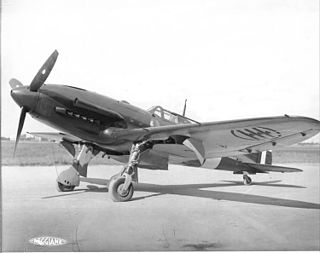
The Reggiane Re.2005 Sagittario was an Italian monoplane fighter and fighter-bomber produced for the Regia Aeronautica during the later years of World War II. Along with the Macchi C.202/C.205 and Fiat G.55, the Reggiane Re.2005 was one of the three Serie 5 Italian fighters. The lines of the fuselage were aerodynamically efficient, and the design was intended to exploit the famous Daimler-Benz DB 605 engine. The only drawback was a certain structural weakness in the rear section of the fuselage. Only 48 examples had been delivered before the Armistice, and these fighters took part in the defence of Naples, Rome and Sicily, with the survivors battling above the crumbling ruins of Berlin, in German insignia. British ace and military observer, Group Captain Duncan Smith, DSO DFC, said that "The Re.2005 was altogether a superb, potent aeroplane".
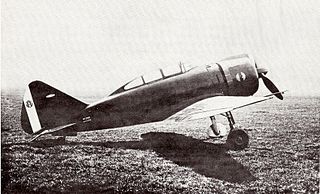
The Reggiane Re.2000 Falco I was an Italian all metal, low-wing monoplane developed and manufactured by aircraft company Reggiane. The type was used by the Regia Aeronautica and the Swedish Air Force during the first part of the Second World War.
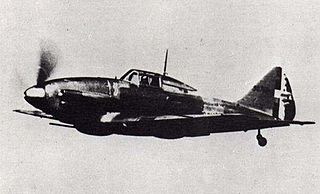
The Reggiane Re.2001 Falco II was an Italian fighter aircraft, serving in the Regia Aeronautica during World War II. A contemporary of the renowned Macchi C.202, the production of this type was to be limited to only 252, but it was a flexible design that proved to be able to undertake a number of roles. Thanks to its maneuverability it could dogfight with more powerful opponents like the Supermarine Spitfire. The Re.2001 became the basis of a later, more formidable fighter, the Re.2005.

The National Republican Air Force was the air force of the Italian Social Republic, a World War II German puppet state in Italy.

The AUT.18 was a prototype fighter aircraft developed in Italy by Aeronautica Umbra shortly before the outbreak of World War II. It was designed in 1934 by Felice Trojani, who at that time was collaborating with Umberto Nobile on the Arctic flights of the airships Norge and Italia. The aircraft's designation came from initials of the manufacturer, the surname of the designer, and the aircraft's wing area, the sole prototype receiving the serial no. M.M.363.
Officine Meccaniche Reggiane SpA was an Italian industrial manufacturer and aviation company.

The Reggiane Re.2002 Ariete ("Ram") was an Italian fighter-bomber developed during World War II. The aircraft was a further development of the Re.2000, with some of the modifications that already had been introduced in the Re.2001. The aircraft was mainly used by the Regia Aeronautica, but it also saw limited use with the German Luftwaffe, who used it against the French resistance.
The Piaggio P.32 was an Italian medium bomber of the late 1930s, produced by Piaggio, and designed by Giovanni Pegna. It was a modern design for its time, but was a failure due to lack of powerplants commensurate with its high wing loading.
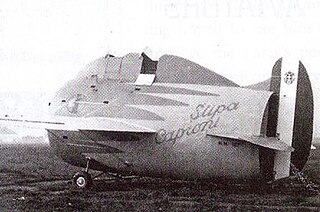
The Stipa-Caproni, also known as the Caproni Stipa, was an experimental Italian aircraft designed in 1932 by Luigi Stipa (1900–1992) and built by Caproni. It featured a hollow, barrel-shaped fuselage with the engine and propeller completely enclosed by the fuselage—in essence, the whole fuselage was a single ducted fan. Although the Regia Aeronautica was not interested in pursuing development of the Stipa-Caproni, its design influenced the development of jet propulsion.

The Reggiane Re.2003 was a development from the Reggiane Re.2002 fighter bomber that first flew on 29 June 1941. It was designed to replace the outdated IMAM Ro.37 used at the time. Unlike the Re.2002, it had room for a second crewman who sat behind the pilot. It was equipped with onboard camera equipment. The Fiat A.74 RC.38 engine was intended to be used originally, but the Piaggio P. XI RC 40 bis was chosen instead. Only one was ever produced, and production for a second started, but never finished. The Regia Aeronautica made an order of 200, but cancelled the order as Allied bombing raids made the Air Force's focus switch to fighter aircraft.

Luigi Stipa was an Italian aeronautical, hydraulic, and civil engineer and aircraft designer who invented the "intubed propeller" for aircraft, a concept that some aviation historians view as the predecessor of the turbofan engine.

The Reggiane Re.2004 was an Italian single-engined monoplane made by Reggiane and designed by Roberto Longhi. The aircraft never passed the preliminary stages.
The Alfa Romeo Avio was an Italian aviation company producing aircraft engines active since 1941. It was founded as a division of Alfa Romeo but was sold to Aeritalia in 1986 and then to Fiat in 1996. It was merged with Fiat Avio in 2003 as Avio S.p.A.
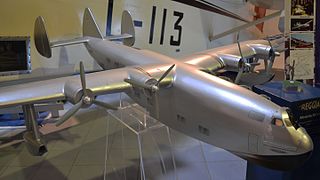
The Caproni-Reggiane Ca.8000 was a four-engine seaplane passenger transport aircraft project for transatlantic crossings.

The Isotta Fraschini Zeta was an air cooled X engine with 24 cylinders developed by the Italian engineering company Isotta Fraschini in the 1940s. It was developed as an indigenous alternative to the imported Daimler-Benz DB 605 that was being built under licence as the Fiat RA.1050 R.C.58 Tifone. The engine was essentially two Gamma V12 engines on a single crankshaft, but proved troublesome to develop and never entered production.